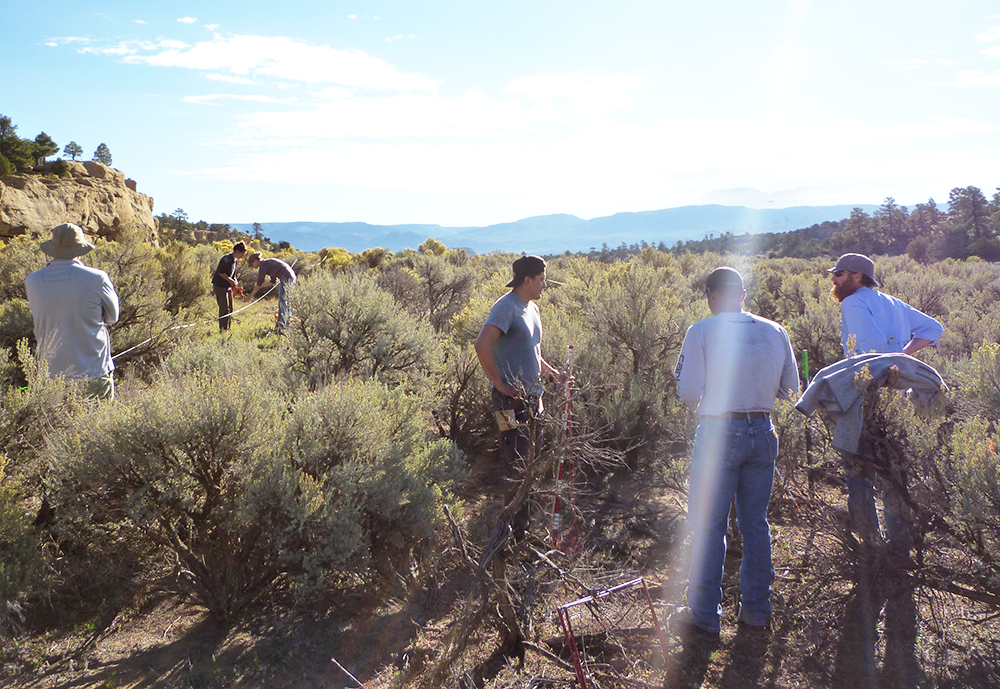NMSU Grad Student Monitoring Effects of Conservation Practices in the Rio Puerco Watershed (continued)
By Catherine Ortega Klett, NM WRRI Program Manager
The Rio Puerco watershed (RPW) in northwestern New Mexico is a highly dynamic and diverse ecological system that has a long history of mostly deleterious anthropogenic alterations. By the early 1900s, heavy grazing pressure and the diversion of water resources for crop irrigation and livestock watering had resulted in drastic alterations to ecosystem structure and function. This has led to reduced herbaceous production leading to lower forage production, greater bare soil, and higher erosion rates. Consequently, although only 4 percent of the Rio Grande’s average annual run-off originates in the RPW, over 70 percent of the Rio Grande’s average annual suspended-sediment load is derived from it. This sediment load is then deposited in Elephant Butte Reservoir, and has been a substantial contributor to the sedimentation and decreased capacity of the reservoir, which then impairs the quality and quantity of water available for production agriculture and domestic use.

The research team collecting plant and soil community measurements.
The primary objectives of this project have been to assess the effects of prescribed grazing and brush management conservation practices on plant and soil communities, wildlife habitat, hydrologic processes, and erosion in the RPW, and to provide a foundation for future range management decisions. To this end, monitoring instrumentation and procedures have been put in place that permit the tracking of responses of the plant and soil biological communities to current ecological management practices. A commonly used practice in this system includes the control of woody species by herbicide application. To assess the impact of this practice, the research team set up a GPS defined grid of monitoring locations and measured before-and-after effects on plant canopy and basal cover, biomass production, as well as soil biological and physical characteristics. They collected pre-treatment measurements last fall, and post-treatment plant and soil community measurements will be collected at the end of this growing season.
The hydrological monitoring is aimed at tracking the runoff of water following precipitation events. This will provide a foundation for improving landscape-scale hydrological models for the RPW. For this purpose, six devices were constructed and installed on the research site in association with climate monitoring stations installed by the NRCS. These climate stations provide a suite of meteorological measurements including precipitation, temperature, and wind speed along with soil moisture and temperature readings at three depths (10, 20, and 50 centimeters). To measure runoff they constructed Upwelling Bernoulli tube monitoring devices out of four-inch Schedule 40 PVC pipe, with vented pressure transducer sensors installed to obtain water level depths within the devices with a resolution of two millimeters. Water depth readings are recorded as a function of time, and estimates of runoff rates can then be inferred and coupled with precipitation event data. This information allows for the establishment of spatially distributed runoff patterns across the installation sites. They are monitoring runoff throughout the growing season, and will use the field-collected data to achieve a greater understanding of how upland conservation practices truly impact the hydrology of the system.
The results of this study should prove useful for state and federal agencies, as well as private landowners, because it will provide a means for evaluating range improvement methodologies, and specifically the impacts those practices may have on the hydrology of the associated systems. Linking upland conservation practices to the quantity and quality of water flowing through those areas will increase our knowledge of potential benefits to water supplies downstream. If conservation practices on rangelands within the RPW can decrease potential runoff and sediment load, the improvement of the ecological and hydrological stability would provide valuable water resources for the state of New Mexico and the borderlands.
